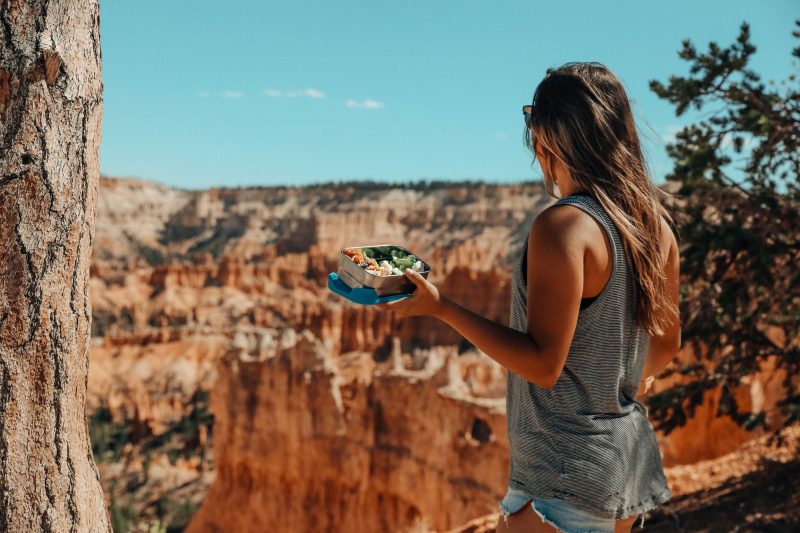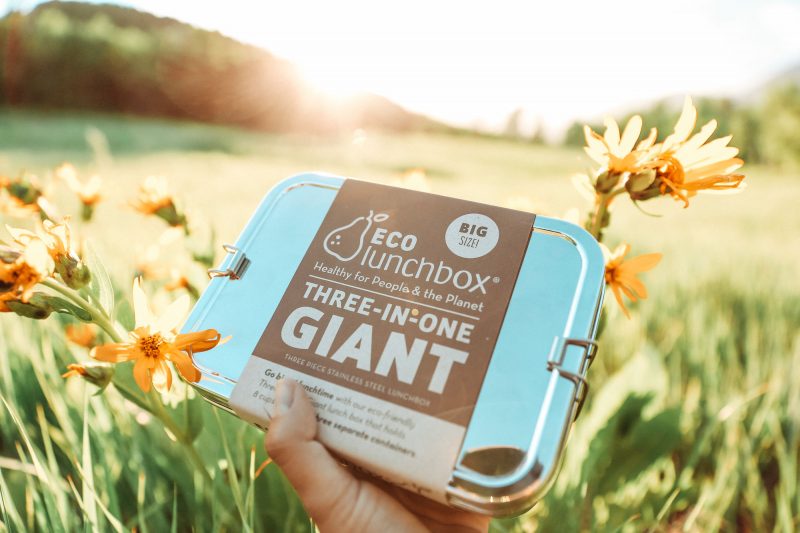
I’m far from living a plastic-free lifestyle, nor am I am expert on the environment and waste, but we can all agree that every little bit helps. The same is true for at home and on the trail.
A new book, Say Goodbye to Plastic, by the founder of the ECOlunchbox, Sandra Ann Harris, offers simple ways to reduce the use of plastic in everyday life. And yes, lots of these are transferrable to the outdoors.
When looking for ways to reduce consumption—on plastic or otherwise—as the book explains, it’s as simple as thinking “reusable, not disposable.” This will not only benefit the earth, but it will benefit your wallet.
A note on recycling: It’s important. Keep doing it. But many plastic products are not made to be recycled. According to Harris, only 1-5% of global plastic that is discarded ever gets recycled. It’s expensive to do with little return (except for, ya know, if you factor in the value of the environment).
Not-so-fun facts about plastic waste
- In Europe and the US, citizens dispose of ONE POUND of plastic every day, compared to less than 1/10th of that in many other developing countries.
- The average American uses 167 plastic water bottles per year (insane)
- Textile (clothing) waste is the second largest contributor to landfills
- US consumers throw away 81 lbs of clothing every year (!) and much of that is made from synthetic materials made from plastics
6 easy plastic replacements for hiking (and life)
- Insulated stainless steel water bottle. There’s tons of options, and you can even for a lightweight reusable plastic water bottle, like the popular Nalgene bottles. Just commit to no more single-use plastic water bottles. Refill your reusable water bottle at filtered refilling stations, which are easy to find now – airports, gas stations, rest stops, malls, etc. The water may not taste like Aquafina, but it’s filtered and safe to drink. If you’re really invested, purify your own water with filtration bottles, UV pens, or carbon-filled straws, which remove harmful bacteria, parasites, and microplastics. Iodine tablets are another popular method for backpackers since they’re lightweight.
- Straw and brush. I know you know about the turtles, and I know you care about the turtles. So stop using plastic single-use straws. Get a straw with a carrying case to keep it clean and a thin brush for easy cleaning. A glass straw is nice so you can see that you’ve thoroughly cleaned it.
- Utensils. Sure, it’s convenient to stash carry-out utensils from restaurants in your backpack for the next time you hit the trail. But it’s also easy to create your own reusable set of utensils and forgo the plastic-wrapped plastic sets altogether. When you get carry-out from a restaurant, politely decline the disposable utensils.
- Glass jars and mint tins. Replace plastic bottles with small glass jars, and store small items in tins rather than plastic baggies.
- ECOLunchbox. These stainless steel lunchboxes are perfect for carrying food on-the-go.
- Aluminum foil. No more saran wrap. Or wax paper, which is covered in a plastic-related product that’s also non-recyclable. Better options: beeswax paper, parchment paper, and aluminum foil, which surprisingly can be recycled if cleaned beforehand.
As always: pack it in, pack it out. Whatever you bring into the wilderness, you take out with you. Go one step further and pick up other people’s trash along the trail. Be the change you wish to see in the world.

Plastic in your clothes
Plastic is in so many materials you would be surprised. Since textiles are one of the major contributors to landfills and full of plastics, let’s take a look at what fabrics are made from plastics and other ways to avoid excess consumption when it comes to outdoor apparel.
- Read the labels. Polyester, nylon, and almost all “vegan leather” materials are molded from petroleum, which takes hundreds of years to break down. What else is plastic? Acrylic, Lycra, spandex, and fleece. On the contrary, these lightweight, semi-synthetic, man-made fabrics are derived from plants, so they’re more sustainable: rayon, viscose, Tencel, and modal. Overall, natural fibers are the best way to go if the environment is your main concern: cotton, wool, hemp, silk, and linen.
- Shop secondhand. When you need a high-quality rain coat or winter jacket or lightweight camping/backpacking gear, you’ll need synthetics. How can you cut down on the consumption of synthetics? Buy these used.
- Only buy what you need. Refer to above bullet on each person throwing away 81 lbs of clothes per year. You save money, and you save the planet. (Says the girl with four vests. Hey, I said I’m not perfect.)
- Research the brands. Know how the clothes are being made and what types of programs the company has in place for offsetting waste.
Simple ways to start ditching plastic in everyday life
Check out Harris’ book for tons of tips on ridding plastic from your home. She breaks it down by room and offers suggestions and alternatives to the convenient but heavy-plastic options we’re all so used to. You don’t have to do everything she says or even half of them. Committing to just a few small changes will still go a long way. Here are some of the easy-peasy ways to reduce your plastic use.
- Stop the use of single-use plastic items like straws, coffee cups, take-out containers, cups, plates, decorations, etc.
- Carry your own straw and bring your own carry-out containers to restaurants to bring leftovers home
- Bring your own grocery bags (I think we’re all doing this by now, yes?)
- Unsubscribe from junk mailing lists and credit card offers, cancel unwanted catalogs and magazines, and switch to paperless billing
- When traveling, bring your own reusable totes. They pack down real small, so there’s no excuse not to. When you’re on the go, it’s tempting to say “yes” if offered a bag when shopping for a few small items. Come prepared with your own tote to carry snacks, souvenirs, etc.
When you buy something using links in our stories, we may earn a small commission. Read more about our policy.
